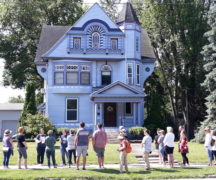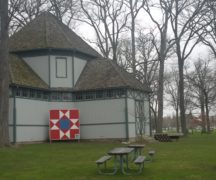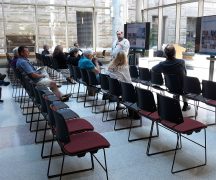The Bowling Green Historic Preservation Commission has selected the stately residence at 707 W. Wooster St. as the historic building of the month for November.
This home is a noteworthy example of an American Foursquare house, a style popular from 1900-1930. Built in 1900 by Murray and Agnetta Chidester, it is easily identified by its simple form with a hipped roof, intriguing hipped dormers, and with a touch of craftsman charm in its delicate detailing of the front porch railings and the porch’s double columns. The adjacent carriage structure is just as stately and well-maintained.
Murray Chidester was born on a farm in western Pennsylvania in 1859 and Agnetta Chidester was born in Crawford County, Pennsylvania, in 1863. They married in 1887. The Chidesters moved to Bays in Wood County in 1890, where they became one of the oil days’ success stories. In one story, the Chidesters took turns pumping the wells, one sleeping while the other pumped, until they eventually struck oil.
Upon their success, they built the house at 707 W. Wooster St., where the land was purchased by Mrs. Chidester from Allen W. Rudolph in 1899. They hired architect Alfred E Hitchcock to design the home, who also was the architect of the Wood County Jail and two other prominent homes in Bowling Green.
While building the home, their only child Murray Brown Chidester was born there in 1900. According to information from the current owner, Alta Codding, since the stairway was not yet completed to the upstairs, Mrs. Chidester and the doctor climbed a ladder in order for the child to be born in their home.
Once the home was completed, Mr. Chidester’s mother, Lucy Chidester, also resided with the family.
Murray Chidester started the MB Chidester and Co. (also known as the Chidester Department Store), a large dry goods store, and was a major stockholder in the Commercial Banking & Savings Co. and director of the BG Board of Trade. The Board of Trade was established to help attract businesses to Bowling Green.
He was given much of the credit for helping to start this board and was a donor to the organization. He also purchased and extensively remodeled the old Hankey-Taber Opera House (formerly located in the building and parking lot that is south of Juniper Brewing Company on South Main Street). After many great investments in oil and real estate, he was estimated to be worth a quarter million dollars.
Mr. Chidester passed away in 1906 at 46 years old. As stated in the Wood County Democrat, a newspaper of the time, at the time of his death he was “universally mourned by our people.” Private funeral services were held at the house, along with a memorial service (after the wishes of the public were expressed) at the Presbyterian Church on South Church Street. He is buried at Oak Grove Cemetery.
Mrs. Chidester later remarried Judge Frank Baldwin (he was a prosecuting attorney and later elected judge for the Wood County Common Pleas Court) in 1916 in the home, attended by only close family and friends. She continued to operate their oil and business holdings. She also was a member of the Bowling Green Woman’s Club and the Presbyterian Church. She had a large Packard touring car, with a chauffeur, and liked to take her friends for rides.
Mr. Baldwin passed away in 1930 and his funeral services were held in their home. He is buried in Oak Grove Cemetery, adjacent to his first wife Clara Foote, who passed away in 1904.
Mrs. Chidester-Baldwin’s son passed away in 1936 in a tragic accident. In his memory, she donated $8,000 (equivalent to about $150,000 today) to the Presbyterian Church for the installation of stained-glass windows. She passed away in 1959 at 96 years old and she is also buried in Oak Grove Cemetery, next to her first husband and son.
The current family purchased the home in January of 1959 and have well cared for the home, including its rich history, since then.
Would you like to nominate a historic building or site for recognition? You can do this through the City website at – https://www.bgohio.org/FormCenter/Planning-13/Historic-BuildingSite-Nomination-Form-83.
You can learn more about the Historic Preservation Commission by attending their meetings on the fourth Tuesday of each month at 4 p.m., or by visiting the webpage at https://www.bgohio.org/436/Historic-Preservation-Commission
(Cheryl Peper, Friend of the Historic Preservation Commission, submitted this article.)





